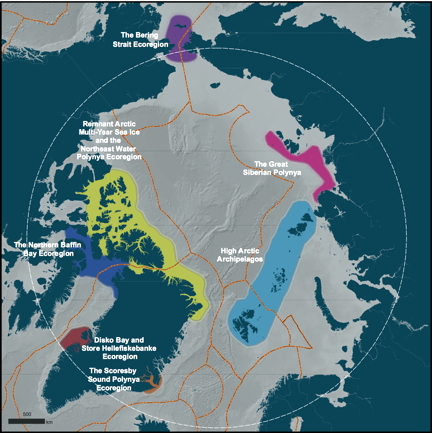“Last Ice Areas” of the polar North should be world heritage sites: IUCN
A coalition of international conservation agencies says two sites in Canada’s Arctic Ocean should qualify as world heritage sites, in a push for additional protection of ice-dependent species that are quickly running out of real estate.
In a recent report titled “Natural Marine Heritage in the Arctic Ocean,” the International Union for Conservation of Nature, or IUCN—in partnership with the United States-based Natural Resources Defense Council and the World Heritage List of the United Nations Educational, Scientific and Cultural Organization—said the Northern Baffin Bay Ecoregion and the Northeast Water Polynya Ecoregion are two of seven areas of “outstanding universal value.”
The report said it studied only the ecological value in the region and did not evaluate cultural heritage.

Together, the sites make up the “Last Ice Area,” a term used for regions where summer sea ice will last the longest.
“The dramatic pace at which Arctic sea ice has declined in recent years highlights the urgency for enhanced understanding and protection of these priceless places of potential [value],” the report said.
“Protection through the 1972 UNESCO World Heritage Convention is one crucial way to secure these places for generations to come.”
The report calls on member states of the UNESCO World Heritage List to fix what it calls a “mismatch” between the goals of UNESCO and the lack of marine conservation in Arctic regions.
Seasonal sea extents in the Arctic have reached record lows in recent years, with March reporting the lowest winter sea ice on record.
At the same time, fishing and other industries have penetrated further into previously isolated regions rich with life, such as the North Water Polynya and the Canada’s High Arctic islands.
“The Arctic Ocean plays a crucial role in shaping global climate and hosts a diverse range of species, many of them threatened,” IUCN’s director of global marine and polar program, Carl Gustaf Lundin, said in an accompanying news release.
“The World Heritage Convention has great potential to increase global recognition and protection of the region’s most exceptional habitats.”
WWF-Canada President and CEO David Miller released a statement coinciding with the report’s publication and supporting its conclusions, adding “we look forward [to] safeguarding the Last Ice Area for Arctic species and the people who depend on them.”
“The Last Ice Area is a crucial habitat for many of Canada’s ice-dependent species, including polar bears, walrus, seals, narwhals, belugas and bowhead whales,” Miller said.
“We must act now to slow the warming of the planet and protect these important refuges.”
Other areas identified in the report include Disko Bay and the Scoresby Sound in Greenland, and waters off the coast of the Svalbard Islands, Siberia and Alaska.